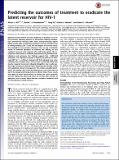Predicting the outcomes of treatment to eradicate the latent reservoir for HIV-1
Author(s)
Hill, Alison Lynn; Rosenbloom, Daniel I. S.; Fu, Feng; Nowak, Martin A.; Siliciano, Robert F.
DownloadHill-2014-Predicting the outco.pdf (999.6Kb)
PUBLISHER_POLICY
Publisher Policy
Article is made available in accordance with the publisher's policy and may be subject to US copyright law. Please refer to the publisher's site for terms of use.
Terms of use
Metadata
Show full item recordAbstract
Massive research efforts are now underway to develop a cure for HIV infection, allowing patients to discontinue lifelong combination antiretroviral therapy (ART). New latency-reversing agents (LRAs) may be able to purge the persistent reservoir of latent virus in resting memory CD4[superscript +] T cells, but the degree of reservoir reduction needed for cure remains unknown. Here we use a stochastic model of infection dynamics to estimate the efficacy of LRA needed to prevent viral rebound after ART interruption. We incorporate clinical data to estimate population-level parameter distributions and outcomes. Our findings suggest that ~2,000-fold reductions are required to permit a majority of patients to interrupt ART for 1 y without rebound and that rebound may occur suddenly after multiple years. Greater than 10,000-fold reductions may be required to prevent rebound altogether. Our results predict large variation in rebound times following LRA therapy, which will complicate clinical management. This model provides benchmarks for moving LRAs from the laboratory to the clinic and can aid in the design and interpretation of clinical trials. These results also apply to other interventions to reduce the latent reservoir and can explain the observed return of viremia after months of apparent cure in recent bone marrow transplant recipients and an immediately-treated neonate.
Date issued
2014-08Department
Harvard University--MIT Division of Health Sciences and TechnologyJournal
Proceedings of the National Academy of Sciences of the United States of America
Publisher
National Academy of Sciences (U.S.)
Citation
Hill, Alison L., Daniel I. S. Rosenbloom, Feng Fu, Martin A. Nowak, and Robert F. Siliciano. “Predicting the Outcomes of Treatment to Eradicate the Latent Reservoir for HIV-1.” Proceedings of the National Academy of Sciences 111, no. 37 (August 5, 2014): 13475–13480. © 2014 National Academy of Sciences
Version: Final published version
ISSN
0027-8424
1091-6490